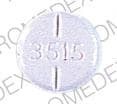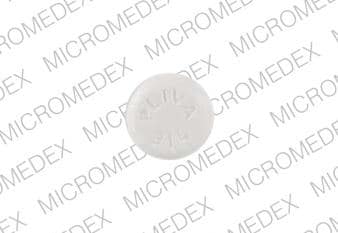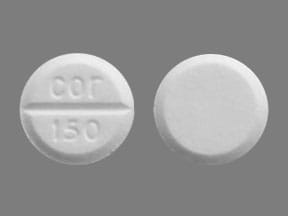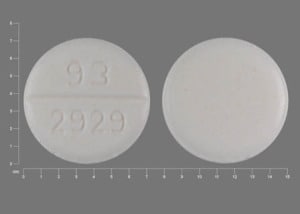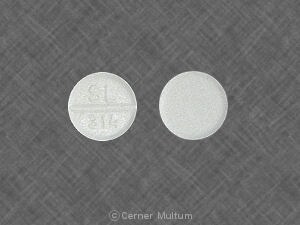Dosage Forms
Excipient information presented when available (limited, particularly for generics); consult specific product labeling. [DSC] = Discontinued product
Syrup, Oral, as hydrochloride:
Generic: 2 mg/5 mL (10 mL [DSC], 473 mL)
Tablet, Oral, as hydrochloride:
Generic: 4 mg
Pharmacology
Mechanism of Action
A potent antihistamine and serotonin antagonist with anticholinergic effects; competes with histamine for H1-receptor sites on effector cells in the gastrointestinal tract, blood vessels, and respiratory tract (Paton 1985).
Pharmacokinetics/Pharmacodynamics
Absorption
Well absorbed (Graudins 1998)
Metabolism
Primarily by hepatic glucuronidation to metabolites (Hintze 1975)
Excretion
Urine (~40% primarily as metabolites); feces (2% to 20%, <6% as unchanged drug)
Time to Peak
Plasma: Metabolites: 6 to 9 hours (Paton 1985)
Half-Life Elimination
Metabolites: ~16 hours (Paton 1985)
Use in Specific Populations
Special Populations: Renal Function Impairment
Elimination is diminished in renal insufficiency.
Use: Labeled Indications
Allergic conditions: Perennial and seasonal allergic rhinitis; vasomotor rhinitis; allergic conjunctivitis caused by inhalant allergens and foods; mild, uncomplicated allergic skin manifestations of urticaria and angioedema; amelioration of allergic reactions to blood or plasma; cold urticaria; dermatographism; adjunctive anaphylactic therapy.
Use: Off Label
Decreased appetite secondary to chronic diseaseb
Data from a small randomized, double-blind, placebo-controlled trial with a long-term extension phase supports the use of cyproheptadine in the treatment of decreased appetite secondary to chronic disease. Additional trials may be necessary to further define the role of cyproheptadine in this condition.
Serotonin syndromec
Data from a limited number of patients studied (case series) suggests that cyproheptadine may be beneficial for the treatment of serotonin syndrome Graudins 1998. Clinical experience also suggests the utility of cyproheptadine for the treatment of this condition Boyer 2005, Sun-Edelstein 2008. Additional data may be necessary to further define the role of cyproheptadine in the treatment of this condition.
Spasticity associated with spinal cord damageb
Data from a double-blind, placebo-controlled, crossover trial supports the use of cyproheptadine in the treatment of spasticity associated with spinal cord damage Wainberg 1990. Additional trials may be necessary to define the role of cyproheptadine in this condition.
Contraindications
Use in newborn or premature infants or breast-feeding mothers; hypersensitivity to cyproheptadine or any component of the formulation; monoamine oxidase inhibitor therapy; angle-closure glaucoma; stenosing peptic ulcer; symptomatic prostatic hypertrophy; bladder neck obstruction; pyloroduodenal obstruction; elderly, debilitated patients.
Dosage and Administration
Dosing: Adult
Allergic conditions: Oral: Initial: 4 mg 3 times daily; maintenance: 4 to 20 mg daily in divided doses; maximum: 0.5 mg/kg/day; some patients may require up to 32 mg/day for adequate control of symptoms
Decreased appetite secondary to chronic disease (off-label use): Oral: Initial: 2 mg 4 times per day for one week, then 4 mg 4 times per day (Homnick 2004; Homnick 2005)
Serotonin syndrome (off-label use): Oral: Initial: 12 mg followed by 2 mg every 2 hours or 4 to 8 mg every 6 hours as needed for symptom control (Boyer 2005; Sun-Edelstein 2008)
Spasticity associated with spinal cord damage (off-label use): Oral: Initial: 2 to 4 mg every 8 hours; maximum: 8 mg every 8 hours (Barbeau 1982; Wainberg 1990)
Dosing: Geriatric
Avoid use (Beers Criteria [AGS 2019]).
Dosing: Pediatric
Allergic conditions: Oral:
Weight-directed or BSA-directed dosing: Children ≥2 years and Adolescents: 0.25 mg/kg/day or 8 mg/m2/day in 2 to 3 divided doses
Fixed-dosing:
2 to 6 years: 2 mg every 8 to 12 hours; maximum daily dose: 12 mg/day
7 to 14 years: 4 mg every 8 to 12 hours; maximum daily dose: 16 mg/day
≥15 years: Initial: 4 mg every 8 hours; titrate to effect; usual range: 12 to 16 mg/day although some patients may require up to 32 mg; maximum daily dose: 0.5 mg/kg/day
Appetite stimulation: Limited data available; dosing regimens variable; Oral:
Weight-directed dosing: Children ≥2 years and Adolescents: 0.25 mg/kg/day divided twice daily; age-dependent maximum daily dose: ≤6 years: 12 mg/day; 7 to 14 years: 16 mg/day; ≥15 years: 32 mg/day. Dosing based on an open-label trial of 66 pediatric cancer patients (median age: 11.7 years; range: 3 to 19 years) which reported 76% response rate (either weight gained or stabilized); mean weight gain: 2.6 kg (range: -0.1 to 10 kg); in a subset analysis, patients >9 years showed a greater response than younger patients as did patients with hematologic malignancies (Couluris 2008).
Fixed dosing: Children ≥5 years and Adolescents: Initial: 2 mg every 6 hours (4 times daily) for 1 week; if tolerated, increase dose to 4 mg every 6 hours; dosing based on a short-term (12-week) double-blind, placebo-controlled trial (n=8 treatment group) and a long-term (1-year) open-label trial (n=12) in cystic fibrosis patients; results showed significant increases in weight gain (3.4 kg vs 1.1 kg in placebo); long-term results showed a generally sustained effect (eg, no further weight loss or some additional weight gain) over study duration (Homnick 2004; Homnick 2005).
Cyclic vomiting syndrome; prevention: Limited data available: Oral: Children 2 to 5 years: 0.25 to 0.5 mg/kg/day in divided doses 2 to 3 times daily; maximum daily dose: 12 mg/day; some clinicians have used once daily dose at bedtime to prevent day time sedation (Andersen 1997; Li 2008)
Dyspeptic syndrome; refractory: Limited data available: Oral: Infants ≥9 months and Children <12 years: Reported range: 0.04 to 0.6 mg/kg/day in divided doses 2 to 3 times daily; median effective dose: 0.22 mg/kg/day; dosing based on a retrospective, open-label trial of 80 pediatric patients (median age: 9.8 years; range: 9 months to 20 years) with dyspeptic symptoms (eg, nausea, early satiety, abdominal pain, retching after fundoplication and vomiting) which failed to respond to conventional therapy (eg, diet changes, H2-blockers, proton pump inhibitors); observed response rate was 55%; a higher response rate (86%) was seen with retching post-Nissen fundoplication (Rodriguez 2013).
Migraine; prophylaxis: Limited data available: Oral: Children ≥3 years and Adolescents: 0.2 to 0.4 mg/kg/day divided twice daily; reported daily dose range: 2 to 8 mg/day; maximum daily dose: 0.5 mg/kg/day; experience suggests younger patients more tolerant of common cyproheptadine side effects (ie, sedation and increased appetite) (Lewis 2004; Lewis 2004a)
Spasticity associated with spinal cord damage: Limited data available; efficacy results variable: Oral: Children ≥12 years and Adolescents: 4 mg at bedtime; increase by a 4 mg dose every 3 to 4 days; mean daily dose: 16 mg/day in divided doses; maximum daily dose: 36 mg/day (Gracie 1997). In the most rigorous evaluation, a double-blind, placebo-controlled, crossover trial of 16 hemiplegic pediatric patients (age range: 4 to 18 years), cyproheptadine (relatively low dose: 1 to 2 mg/day) had no statistical evidence of an effect on gait nor improvement in spasticity parameters (Khodadadeh 1998)
Storage
Oral syrup: Store at 20°C to 25°C (68°F to 77°F); protect from light.
Oral tablets: Store at 20°C to 25°C (68°F to 77°F).
Cyproheptadine Images
Drug Interactions
Acetylcholinesterase Inhibitors: May diminish the therapeutic effect of Anticholinergic Agents. Anticholinergic Agents may diminish the therapeutic effect of Acetylcholinesterase Inhibitors. Monitor therapy
Aclidinium: May enhance the anticholinergic effect of Anticholinergic Agents. Avoid combination
Alcohol (Ethyl): CNS Depressants may enhance the CNS depressant effect of Alcohol (Ethyl). Monitor therapy
Alizapride: May enhance the CNS depressant effect of CNS Depressants. Monitor therapy
Amantadine: May enhance the anticholinergic effect of Anticholinergic Agents. Monitor therapy
Amezinium: Antihistamines may enhance the stimulatory effect of Amezinium. Monitor therapy
Amphetamines: May diminish the sedative effect of Antihistamines. Monitor therapy
Anticholinergic Agents: May enhance the adverse/toxic effect of other Anticholinergic Agents. Monitor therapy
Azelastine (Nasal): CNS Depressants may enhance the CNS depressant effect of Azelastine (Nasal). Avoid combination
Benzylpenicilloyl Polylysine: Antihistamines may diminish the diagnostic effect of Benzylpenicilloyl Polylysine. Management: Suspend systemic H1 antagonists for benzylpenicilloyl-polylysine skin testing and delay testing until systemic antihistaminic effects have dissipated. A histamine skin test may be used to assess persistent antihistaminic effects. Consider therapy modification
Betahistine: Antihistamines may diminish the therapeutic effect of Betahistine. Monitor therapy
Blonanserin: CNS Depressants may enhance the CNS depressant effect of Blonanserin. Consider therapy modification
Botulinum Toxin-Containing Products: May enhance the anticholinergic effect of Anticholinergic Agents. Monitor therapy
Brexanolone: CNS Depressants may enhance the CNS depressant effect of Brexanolone. Monitor therapy
Brimonidine (Topical): May enhance the CNS depressant effect of CNS Depressants. Monitor therapy
Bromopride: May enhance the CNS depressant effect of CNS Depressants. Monitor therapy
Bromperidol: May enhance the CNS depressant effect of CNS Depressants. Avoid combination
Buprenorphine: CNS Depressants may enhance the CNS depressant effect of Buprenorphine. Management: Consider reduced doses of other CNS depressants, and avoiding such drugs in patients at high risk of buprenorphine overuse/self-injection. Initiate buprenorphine at lower doses in patients already receiving CNS depressants. Consider therapy modification
Cannabidiol: May enhance the CNS depressant effect of CNS Depressants. Monitor therapy
Cannabis: May enhance the CNS depressant effect of CNS Depressants. Monitor therapy
Chloral Betaine: May enhance the adverse/toxic effect of Anticholinergic Agents. Monitor therapy
Chlormethiazole: May enhance the CNS depressant effect of CNS Depressants. Management: Monitor closely for evidence of excessive CNS depression. The chlormethiazole labeling states that an appropriately reduced dose should be used if such a combination must be used. Consider therapy modification
Chlorphenesin Carbamate: May enhance the adverse/toxic effect of CNS Depressants. Monitor therapy
Cimetropium: Anticholinergic Agents may enhance the anticholinergic effect of Cimetropium. Avoid combination
CNS Depressants: May enhance the adverse/toxic effect of other CNS Depressants. Monitor therapy
Dimethindene (Topical): May enhance the CNS depressant effect of CNS Depressants. Monitor therapy
Doxylamine: May enhance the CNS depressant effect of CNS Depressants. Management: The manufacturer of Diclegis (doxylamine/pyridoxine), intended for use in pregnancy, specifically states that use with other CNS depressants is not recommended. Monitor therapy
Dronabinol: May enhance the CNS depressant effect of CNS Depressants. Monitor therapy
Droperidol: May enhance the CNS depressant effect of CNS Depressants. Management: Consider dose reductions of droperidol or of other CNS agents (eg, opioids, barbiturates) with concomitant use. Exceptions to this monograph are discussed in further detail in separate drug interaction monographs. Consider therapy modification
Eluxadoline: Anticholinergic Agents may enhance the constipating effect of Eluxadoline. Avoid combination
Esketamine: May enhance the CNS depressant effect of CNS Depressants. Monitor therapy
Flunitrazepam: CNS Depressants may enhance the CNS depressant effect of Flunitrazepam. Consider therapy modification
Gastrointestinal Agents (Prokinetic): Anticholinergic Agents may diminish the therapeutic effect of Gastrointestinal Agents (Prokinetic). Monitor therapy
Glucagon: Anticholinergic Agents may enhance the adverse/toxic effect of Glucagon. Specifically, the risk of gastrointestinal adverse effects may be increased. Monitor therapy
Glycopyrrolate (Oral Inhalation): Anticholinergic Agents may enhance the anticholinergic effect of Glycopyrrolate (Oral Inhalation). Avoid combination
Glycopyrronium (Topical): May enhance the anticholinergic effect of Anticholinergic Agents. Avoid combination
Hyaluronidase: Antihistamines may diminish the therapeutic effect of Hyaluronidase. Management: Patients receiving antihistamines (particularly at larger doses) may not experience the desired clinical response to standard doses of hyaluronidase. Larger doses of hyaluronidase may be required. Consider therapy modification
HYDROcodone: CNS Depressants may enhance the CNS depressant effect of HYDROcodone. Management: Avoid concomitant use of hydrocodone and benzodiazepines or other CNS depressants when possible. These agents should only be combined if alternative treatment options are inadequate. If combined, limit the dosages and duration of each drug. Consider therapy modification
HydrOXYzine: May enhance the CNS depressant effect of CNS Depressants. Monitor therapy
Ipratropium (Oral Inhalation): May enhance the anticholinergic effect of Anticholinergic Agents. Avoid combination
Itopride: Anticholinergic Agents may diminish the therapeutic effect of Itopride. Monitor therapy
Kava Kava: May enhance the adverse/toxic effect of CNS Depressants. Monitor therapy
Lemborexant: May enhance the CNS depressant effect of CNS Depressants. Management: Dosage adjustments of lemborexant and of concomitant CNS depressants may be necessary when administered together because of potentially additive CNS depressant effects. Close monitoring for CNS depressant effects is necessary. Consider therapy modification
Levosulpiride: Anticholinergic Agents may diminish the therapeutic effect of Levosulpiride. Avoid combination
Lofexidine: May enhance the CNS depressant effect of CNS Depressants. Management: Drugs listed as exceptions to this monograph are discussed in further detail in separate drug interaction monographs. Monitor therapy
Magnesium Sulfate: May enhance the CNS depressant effect of CNS Depressants. Monitor therapy
Methotrimeprazine: CNS Depressants may enhance the CNS depressant effect of Methotrimeprazine. Methotrimeprazine may enhance the CNS depressant effect of CNS Depressants. Management: Reduce adult dose of CNS depressant agents by 50% with initiation of concomitant methotrimeprazine therapy. Further CNS depressant dosage adjustments should be initiated only after clinically effective methotrimeprazine dose is established. Consider therapy modification
MetyroSINE: CNS Depressants may enhance the sedative effect of MetyroSINE. Monitor therapy
Mianserin: May enhance the anticholinergic effect of Anticholinergic Agents. Monitor therapy
Minocycline (Systemic): May enhance the CNS depressant effect of CNS Depressants. Monitor therapy
Mirabegron: Anticholinergic Agents may enhance the adverse/toxic effect of Mirabegron. Monitor therapy
Monoamine Oxidase Inhibitors: May enhance the anticholinergic effect of Cyproheptadine. Cyproheptadine may diminish the serotonergic effect of Monoamine Oxidase Inhibitors. Avoid combination
Nabilone: May enhance the CNS depressant effect of CNS Depressants. Monitor therapy
Nitroglycerin: Anticholinergic Agents may decrease the absorption of Nitroglycerin. Specifically, anticholinergic agents may decrease the dissolution of sublingual nitroglycerin tablets, possibly impairing or slowing nitroglycerin absorption. Monitor therapy
Opioid Agonists: CNS Depressants may enhance the CNS depressant effect of Opioid Agonists. Management: Avoid concomitant use of opioid agonists and benzodiazepines or other CNS depressants when possible. These agents should only be combined if alternative treatment options are inadequate. If combined, limit the dosages and duration of each drug. Consider therapy modification
Orphenadrine: CNS Depressants may enhance the CNS depressant effect of Orphenadrine. Avoid combination
Oxatomide: May enhance the anticholinergic effect of Anticholinergic Agents. Avoid combination
Oxomemazine: May enhance the CNS depressant effect of CNS Depressants. Avoid combination
OxyCODONE: CNS Depressants may enhance the CNS depressant effect of OxyCODONE. Management: Avoid concomitant use of oxycodone and benzodiazepines or other CNS depressants when possible. These agents should only be combined if alternative treatment options are inadequate. If combined, limit the dosages and duration of each drug. Consider therapy modification
Paraldehyde: CNS Depressants may enhance the CNS depressant effect of Paraldehyde. Avoid combination
Perampanel: May enhance the CNS depressant effect of CNS Depressants. Management: Patients taking perampanel with any other drug that has CNS depressant activities should avoid complex and high-risk activities, particularly those such as driving that require alertness and coordination, until they have experience using the combination. Consider therapy modification
Piribedil: CNS Depressants may enhance the CNS depressant effect of Piribedil. Monitor therapy
Pitolisant: Antihistamines may diminish the therapeutic effect of Pitolisant. Avoid combination
Potassium Chloride: Anticholinergic Agents may enhance the ulcerogenic effect of Potassium Chloride. Management: Patients on drugs with substantial anticholinergic effects should avoid using any solid oral dosage form of potassium chloride. Avoid combination
Potassium Citrate: Anticholinergic Agents may enhance the ulcerogenic effect of Potassium Citrate. Avoid combination
Pramipexole: CNS Depressants may enhance the sedative effect of Pramipexole. Monitor therapy
Pramlintide: May enhance the anticholinergic effect of Anticholinergic Agents. These effects are specific to the GI tract. Consider therapy modification
Ramosetron: Anticholinergic Agents may enhance the constipating effect of Ramosetron. Monitor therapy
Revefenacin: Anticholinergic Agents may enhance the anticholinergic effect of Revefenacin. Avoid combination
ROPINIRole: CNS Depressants may enhance the sedative effect of ROPINIRole. Monitor therapy
Rotigotine: CNS Depressants may enhance the sedative effect of Rotigotine. Monitor therapy
Rufinamide: May enhance the adverse/toxic effect of CNS Depressants. Specifically, sleepiness and dizziness may be enhanced. Monitor therapy
Secretin: Anticholinergic Agents may diminish the therapeutic effect of Secretin. Management: Avoid concomitant use of anticholinergic agents and secretin. Discontinue anticholinergic agents at least 5 half-lives prior to administration of secretin. Consider therapy modification
Selective Serotonin Reuptake Inhibitors: Cyproheptadine may diminish the therapeutic effect of Selective Serotonin Reuptake Inhibitors. Monitor therapy
Sodium Oxybate: May enhance the CNS depressant effect of CNS Depressants. Management: Consider alternatives to combined use. When combined use is needed, consider minimizing doses of one or more drugs. Use of sodium oxybate with alcohol or sedative hypnotics is contraindicated. Consider therapy modification
Suvorexant: CNS Depressants may enhance the CNS depressant effect of Suvorexant. Management: Dose reduction of suvorexant and/or any other CNS depressant may be necessary. Use of suvorexant with alcohol is not recommended, and the use of suvorexant with any other drug to treat insomnia is not recommended. Consider therapy modification
Tapentadol: May enhance the CNS depressant effect of CNS Depressants. Management: Avoid concomitant use of tapentadol and benzodiazepines or other CNS depressants when possible. These agents should only be combined if alternative treatment options are inadequate. If combined, limit the dosages and duration of each drug. Consider therapy modification
Tetrahydrocannabinol: May enhance the CNS depressant effect of CNS Depressants. Monitor therapy
Tetrahydrocannabinol and Cannabidiol: May enhance the CNS depressant effect of CNS Depressants. Monitor therapy
Thalidomide: CNS Depressants may enhance the CNS depressant effect of Thalidomide. Avoid combination
Thiazide and Thiazide-Like Diuretics: Anticholinergic Agents may increase the serum concentration of Thiazide and Thiazide-Like Diuretics. Monitor therapy
Tiotropium: Anticholinergic Agents may enhance the anticholinergic effect of Tiotropium. Avoid combination
Topiramate: Anticholinergic Agents may enhance the adverse/toxic effect of Topiramate. Monitor therapy
Trimeprazine: May enhance the CNS depressant effect of CNS Depressants. Monitor therapy
Umeclidinium: May enhance the anticholinergic effect of Anticholinergic Agents. Avoid combination
Zolpidem: CNS Depressants may enhance the CNS depressant effect of Zolpidem. Management: Reduce the Intermezzo brand sublingual zolpidem adult dose to 1.75 mg for men who are also receiving other CNS depressants. No such dose change is recommended for women. Avoid use with other CNS depressants at bedtime; avoid use with alcohol. Consider therapy modification
Test Interactions
Diagnostic antigen skin test results may be suppressed; false positive serum TCA screen (Wians 1993)
Adverse Reactions
Frequency not defined.
Cardiovascular: Extrasystoles, hypotension, palpitations, tachycardia
Central nervous system: Ataxia, chills, confusion, dizziness, drowsiness, euphoria, excitement, fatigue, hallucination, headache, hysteria, insomnia, irritability, nervousness, neuritis, paresthesia, restlessness, sedation, seizure, vertigo
Dermatologic: Diaphoresis, skin photosensitivity, skin rash, urticaria
Gastrointestinal: Abdominal pain, anorexia, cholestasis, constipation, diarrhea, increased appetite, nausea, vomiting, xerostomia
Genitourinary: Difficulty in micturition, urinary frequency, urinary retention
Hematologic & oncologic: Agranulocytosis, hemolytic anemia, leukopenia, thrombocytopenia
Hepatic: Hepatic failure, hepatitis, jaundice
Hypersensitivity: Anaphylactic shock, angioedema, hypersensitivity reaction
Neuromuscular & skeletal: Tremor
Ophthalmic: Blurred vision, diplopia
Otic: Labyrinthitis (acute), tinnitus
Respiratory: Nasal congestion, pharyngitis, thickening of bronchial secretions
Warnings/Precautions
Concerns related to adverse effects:
- CNS depression: May cause CNS depression, which may impair physical or mental abilities; patients must be cautioned about performing tasks which require mental alertness (eg, operating machinery or driving).
Disease-related concerns:
- Cardiovascular disease: Use with caution in patients with cardiovascular disease (including hypertension and ischemic heart disease).
- Increased intraocular pressure: Use with caution in patients with increased intraocular pressure.
- Respiratory disease: Use with caution in patients with asthma or other chronic breathing disorders.
- Thyroid dysfunction: Use with caution in patients with thyroid dysfunction.
Concurrent drug therapy issues:
- Drug-drug interactions: Potentially significant interactions may exist, requiring dose or frequency adjustment, additional monitoring, and/or selection of alternative therapy. Consult drug interactions database for more detailed information.
Special populations:
- Elderly: Antihistamines are more likely to cause dizziness, sedation and hypotension in elderly patients.
- Pediatric: Antihistamines may cause excitation in young children.
Pregnancy
Pregnancy Risk Factor
B
Pregnancy Considerations
Adverse events were observed in some animal reproduction studies. Per the product labeling, an increased risk of congenital abnormalities was not observed following maternal use of cyproheptadine during the first, second, or third trimesters in two studies of pregnant women; however the possibility of harm cannot be ruled out. Although cyproheptadine is approved for the treatment of allergic conditions such as rhinitis and uritcaria, other agents are preferred for use in pregnant women (Scadding 2008; Wallace 2008; Zuberbier 2014). Antihistamines are not recommended for treatment of pruritus associated with intrahepatic cholestasis in pregnancy (Ambros-Rudolph 2011; Kremer 2014).
Patient Education
What is this drug used for?
- It is used to ease allergy signs.
- It is used to treat hives.
- It may be given to you for other reasons. Talk with the doctor.
Frequently reported side effects of this drug
- Fatigue
- Headache
- Diarrhea
- Vomiting
- Abdominal pain
- Constipation
- Dry mouth
- Dry nose
- Runny nose
- Anxiety
- Nausea
- Tremors
- Trouble sleeping
- Lack of appetite
- Increased appetite
- Weight gain
- Restlessness
Other side effects of this drug: Talk with your doctor right away if you have any of these signs of:
- Liver problems like dark urine, fatigue, lack of appetite, nausea, abdominal pain, light-colored stools, vomiting, or yellow skin or eyes
- Severe dizziness
- Passing out
- Fast heartbeat
- Abnormal heartbeat
- Trouble urinating
- Change in amount of urine passed
- Severe loss of strength and energy
- Confusion
- Change in balance
- Burning or numbness feeling
- Vision changes
- Noise or ringing in the ears
- Sweating a lot
- Menstrual changes
- Sensing things that seem real but are not
- Irritability
- Mood changes
- Seizures
- Chills
- Sore throat
- Bruising
- Bleeding
- Signs of a significant reaction like wheezing; chest tightness; fever; itching; bad cough; blue skin color; seizures; or swelling of face, lips, tongue, or throat.
Note: This is not a comprehensive list of all side effects. Talk to your doctor if you have questions.
Consumer Information Use and Disclaimer: This information should not be used to decide whether or not to take this medicine or any other medicine. Only the healthcare provider has the knowledge and training to decide which medicines are right for a specific patient. This information does not endorse any medicine as safe, effective, or approved for treating any patient or health condition. This is only a brief summary of general information about this medicine. It does NOT include all information about the possible uses, directions, warnings, precautions, interactions, adverse effects, or risks that may apply to this medicine. This information is not specific medical advice and does not replace information you receive from the healthcare provider. You must talk with the healthcare provider for complete information about the risks and benefits of using this medicine.
